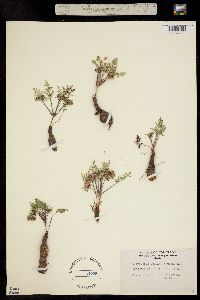Cymopterus glomeratus
|
|
|
|
Family: Apiaceae
Fendler's springparsley, more...Plains Spring-Parsley, plains spring parsley, plains springparsley, stemless springparsley, wild parsley, plains springparsley
[Cymopterus acaulis (Pursh) Raf., moreCymopterus acaulis var. fendleri (A. Gray) Goodrich, Cymopterus acaulis var. greeleyorum J. Grimes & Packard, Cymopterus acaulis var. parvus Goodrich, Cymopterus fendleri Gray, Cymopterus glomeratus var. fendleri , Ferula palmella , Pseudocymopterus purpureus , Thapsia glomerata Nutt.] |
The half-sphere of tightly packed clusters of flowers is characteristic of flowers in this genus and family. To distinguish among the members of the genus, look especially at the pattern of the leaf divisions, the color and texture of the leaves, the size and shape of the bracts below the flower head, and, of course, the flower color. The bracts (the "involucels") of each flower cluster are prominent, deeply cut, green, and top a flower stalk that equals or exceeds the leaves. Heil et al 2013, Kearney and Peebles 1960, Correll and Johnston 1979 Duration: Perennial Nativity: Native Lifeform: Forb/Herb General: Perennial herb from a long, deep-seated taproot, acaulescent or subacaulescent; stems 7-18 cm long, mostly subterranean; herbage often viscid and dotted with sand grains. Leaves: Basal, or more often appearing basal but actually whorled and subtending the peduncles atop a partially buried pseudoscape; petioles 2-8 cm long; blades up to 7 cm long, oblong, ovate or linear in outline, 2-3 times pinnate with 1-3 opposite pairs of lateral primary leaflets; primary leaflets 5-35 mm long, gradually reduced upward, pinnate to bipinnatifid with few to several rounded to narrow lobes, the ultimate teeth or lobes 1 cm long and 2 mm wide. Flowers: Inflorescences are compound umbels (1-14 per plant) on peduncles that equal or exceed the leaves, to 14 cm long; umbels lacking involucres; rays 6-9, 1-13 mm long; bractlets of the involucel 3-8 mm long, sometimes exceeding the flowers, 1-4 mm wide, united at the base, green or purple in age, the same texture as the leaves; pedicels to 2 mm long; flowers with green calyx teeth, yellow petals fading to white or cream when dried. Fruits: Capsule splitting into 2 single seeded mericarps, straight or slightly wavy, mostly entire or obscurely erose, to 1 cm long, slightly corky, with marginal wings about half as broad as the body. Ecology: Found in high desert communities including desertscrub, sagebrush, blackbrush, and pinyon-juniper, often in sandy soils; 4,500-7,500 ft (1372-2286 m); flowers May to June. Distribution: TX, CO, UT, NM, n AZ, n MEX Notes: This is the common yellow-flowered spring parsley of the Colorado Plateau, especially in the Four Corners region, though its range does extend down the Rio Grande valley into southern New Mexico, west Texas and Chihuahua. Look in the springtime for low, small plants with rosettes of dark green, sticky leaves that resemble large Italian parsley leaves; clusters of yellow flowers elevated on stalks above the leaves; and, later in the season, clusters of dry, winged, purple-tinged fruits. Ethnobotany: Navajo used the leaves as a vegetable and a seasoning. Etymology: Cymopterus comes from the Greek kuma, "wave," and pteron, "wing," referring to the winged fruits; glomeratus means densely clustered, alluding to the inflorescences, Synonyms: Cymopterus fendleri, Cymopterus acaulis Editor: AHazelton 2015 Lvs clustered near the ground level on a pseudoscape arising from the subterranean crown of a long, stout taproot, pinnately dissected, the blade to 8 cm; scape-like peduncles usually several, 2-10 cm at maturity; infl dense, the 3-5 rays seldom 1 cm, the pedicels 1 mm; fls white; bractlets rather broad, connate below; fr ovoid to broadly oblong, 5-10 mm, without a carpophore. Dry plains and prairies; w. Minn. to Sask., Mont., Oreg., Ariz., and n. Mex. May, June. Ours is var. acaulis. Gleason, Henry A. & Cronquist, Arthur J. 1991. Manual of vascular plants of northeastern United States and adjacent Canada. lxxv + 910 pp. ©The New York Botanical Garden. All rights reserved. Used by permission. |



































































































